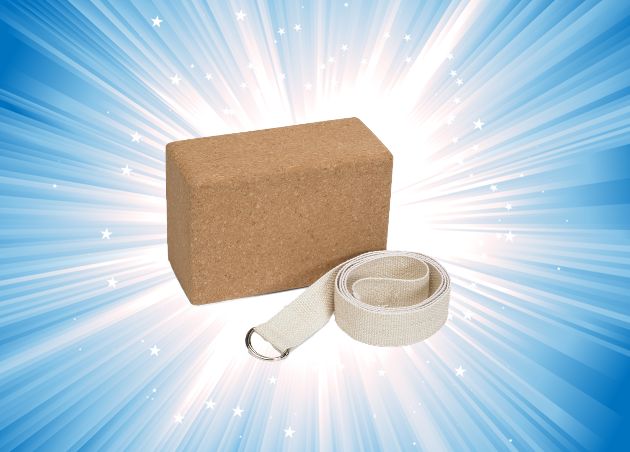Being a Vinyasa Flow teacher and practitioner I’ve witnessed all manner of reactions to the suggestion to use blocks, straps or other props in class. Unlike other yoga styles, props aren’t always included in the vinyasa flow party. Some might even say they’re shunned, like a pair of training wheels at the Tour de France. I get it. Props can slow the flow down, and indeed, when I first started practicing I thought using props was a sign of weakness, i.e. if I couldn’t get in the pose without the help of a prop, I wasn’t trying hard enough.
However, my attitude about props changed when I trained to be a yoga teacher. My teachers taught me to look at props not as a crutch, but rather a foundation to better understand and explore body alignment. My awareness only grew when I started to teach my own classes and I could more clearly see the wisdom in using props to deepen one’s experience on the mat. I’d see students attempt poses like Airplane (Virabhadrasana III variation), Triangle (Utthita Trikonasana) or Half Moon (Ardha Chandrasana), with their hands flailing towards the floor with no grounding and their spines often bending at angles that look anything but comfortable. When I’d insert a block into the mix, the transformation was immediate; their bodies literally blossomed into the pose with more ease.
From blocks, straps and bolsters to blankets, chairs and walls, props afford more capability to all yogis, from beginners to more advanced. So if you refuse to grab a block in class, these reasons could inspire you to rethink your original opinion.
With yoga props. . .
1. You Don’t Miss Out On The Experience
Not everyone is as naturally flexible as a teenage boy (among some of the first yogis). With people of all shapes, sizes and ages practicing yoga, props offer alternative, accessible variations so everyone can experience the pose true to their own body’s needs, rather than sitting out during a pose or risking injury trying to attempt a challenging pose without help.
2. Get A Lesson In True Alignment
Believe it or not, but using props doesn’t always mean the yoga gets easier. When used correctly, props don’t allow you to cheat, and instead you learn the true mechanics of the pose. For example, pressing your lifted foot against a wall in a supported Airplane reminds you to engage your lifted leg as well as your core and back muscles. Or having a block balanced on your pelvis reminds you to keep your hips level and legs engaged in Pyramid (Parsvottanasana) or Revolved Triangle (Parivrtta Trikonasana).
3. Cultivate True Comfort
Think about using a blanket for padding when you drop your knee to the floor in Low Lunge (Anjaneyasana) or Half Split (Ardha Hanumanasana), wedging a block under your front hip in One-Legged King Pigeon (Eka Pada Rajakapotasana), or using a foam wedge to relieve strained wrists in Downward Facing Dog (Adho Mukha Svanasana). Props can reduce the struggle or avoid pain in getting into a pose altogether. Then they leave room for you can better experience the pose’s original aims, not dwell on discomfort.
4. Get A Taste For Deep Relaxation
Some of the best calming postures can be further enhanced by props. Corpse Pose (Savasana) can feel so much sweeter when you have blankets supporting your head or knees and perhaps even one keeping you warm. Supported Reclined Bound Angle (Supta Baddha Konasana) can take on more heart opening and shoulder releasing when you have a bolster to lie upon. In these ways, props do some of the work for you so you can relax more fully. Not a bad side effect at all.
Training Wheels To Freedom
While props may be training wheels in some respect, ultimately they do become great learning tools that help you get smarter, more in tune to your body, and more creative in your practice. Your practice becomes more adaptable so when injuries or any other changes occur, your yoga doesn’t have to stop altogether. Ultimately, props encourage your practice to be more versatile, and who wouldn’t like that?


